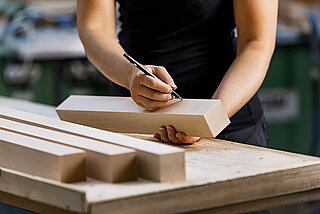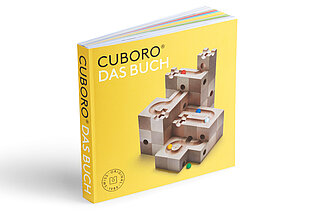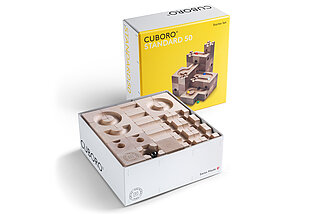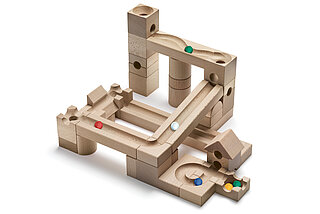
The art of simplicity
Cuboro turns an original shape made of clay into an ingenious game concept
By Sibylle Dorndorf
To create a genuinely timeless product requires focus on the essential and the desire for simplicity. The architect, Ludwig Mies van der Rohe once said: "Less is more!" Matthias Etter succeeded in achieving this. While working with children with mental and physical disabilities, the Swiss native devised learning tools like puzzles, simple musical instruments, and three-dimensional tactile objects in the seventies. This then became the basic Cuboro shape. Etter, driven by an ingenious idea, produced first prototypes made from fir wood which followed the original shape made of clay: cubes with grooves and tunnels that had to be connected. Measuring the success of the game’s principle is brilliantly simple: if the marbles roam freely through the system, the puzzle has been completed with success. If a marble rolls all the way to the end, the task has been achieved.

The basic idea of the Cuboro marble run system was born. And Matthias Etter continued with his experiments. He tried to build first prototypes made of wood to find an even more balanced combination of the different cubes. A set with 48 elements is the result. In 1985, the first small series made of beech wood was called Konstrito and sold on the Christmas bazaar in Berne. People made a run for the marble run system. Its crisp design, the simplicity of the wood elements and seemingly infinite combinations fascinate people regardless of age. The system adapts to the level of the player. Solutions are found through logical thinking, trial and error, or feeling your way around.
The birth of Cuboro
1986 marks the birth of Cuboro. Matthias Etter finds a partner in the joinery, Nyfeler Holzwaren AG which produces the Cuboro elements with know-how, heart and soul to this day.
In the same year, Cuboro launches at the Swiss industry trade fair, Ornaris – a spontaneous and highly-motivated display on a small exhibition area which proves to be a long-term win: Etter manages to gain the Panda catalogue of WWF Switzerland as a client for Cuboro. The high value and sustainability of his product win them over.
In the years that follow, the entrepreneur continues to further refine the Cuboro range. The first extra sets that are compatible with the starter set broaden the physical and mathematical possibilities and therefore, the play value. Cuboro becomes more popular far beyond Switzerland’s borders. The product’s timeless design wins multiple international design and toy awards. In 1994, the time is right for Matthias Etter to introduce Cuboro to an international audience at the toy fair in Nuremberg. This also proves to be a step that pays off: Etter makes valuable contacts. A customer in Germany organises the material and shipping warehouse for the EU market.
Cuboro AG is incorporated

Following this expansion, Etter takes a more professional approach and gradually grows his product range. In 1997, he incorporates Cuboro AG and continues to design other Cuboro extra sets. The first Cuboro The Book is published – a comprehensive reference full of information, blueprints, tricky quizzes and competitions on the Cuboro marble run range. The game system becomes a brand and creates considerable momentum. Cuboro conquers new continents – and a new dimension: The first version of the virtual Cuboro Webkit for playing online is created. At the same time, an agency is set up in USA. Internationalisation keeps moving forward: At the start of the new millennium, first enquiries from South Korea and Japan arrive. In 2005, Cuboro participates in the Expo 05 world exhibition in Aichi, Japan as a Best of Switzerland product. This step turns out to be pioneering a few years later: In 2017, a Japanese neuro-scientist confirms in a documentary on the youngest Shogi chess professional that playing Cuboro is crucial in training children’s mental capacities.
New product lines supplement the programme

Meanwhile, Matthias Etter continues to refine his marble run system and moves to encompass new target audiences. With the Cuboro Cugolino set he creates a product line for small children for the first time. Alongside this, Cuboro products and their packaging are given a professional overhaul. In-company process flows are adapted to the growth while maintaining Cuboro values. The production – still in Switzerland to this day – is upgraded in line with strict sustainability guidelines.
In the meantime, the Cuboro system has entered many lesson plans. With further books, instructions for team workshops and the Cuboro Creative Thinking teaching resources, Matthias Etter focuses further on this didactic orientation as from 2010. Again, he grows the radius of this target audience: In 2013, Cuboro Tricky Ways is published – an exciting strategy game for the whole family based on the Cuboro system. The teaching resource and the new board game are an international success. Cuboro Creating Thinking is translated into English and Russian and becomes an officially recognised teaching resource in Russia.
New design and new generation

At the start of 2020, Matthias Etter passes the reigns of the company to his son, Sebastian. With the new generation, the location of Cuboro AG is moved to Berne. A lot of new impetus and one constant – rarely do generational changes run this smoothly and are this future-focused, as Sebastian Etter acknowledges: "I was extremely lucky to have grown up with Cuboro. I experienced first-hand how curiosity and an inventive mind can create an idea that can be developed into a popular product. As a child, I already helped my father in the workshop. The fascination was sparked and my vision of Cuboro has matured over the years. When I finally took over the business, I was well prepared and focused. We moved the Cuboro product range forward with a lot of respect and created a new, appealing design." And even Sebastian Etter continues to work towards building an ever-more customer-centric Cuboro range while at the same time designing a highly appealing and timeless marble run range with a steadfast USP. And he never shies away from pro-actively facing new challenges. Sebastian Etter drives digitalisation and the organisation of the global collaboration with retailers forward, continues to grow Cuboro and launches a comprehensive redesign of Cuboro products in 2020. One thing is clear to see: Even under the new management, outstanding product quality remains the focus.
Time for Cuboro
The former hidden champion has become a brand which embodies precisely what today’s young parents and adults seek: Genuinely sustainable products and a counterpart to the digital world. The latter is guaranteed by a sophisticated playing system. Combining the natural long-living materials with a cross-generational game idea fulfils the principles of genuine sustainability. "It is not only the material that lasts a lifetime, but also the joy of playing Cuboro. A lot of positive feedback from around the world shows that this approach is more important than ever. We receive feedback especially from parents saying that their children – thanks to Cuboro – are more focused again and concentrate and play for longer periods at a time in analogue mode", says Sebastian Etter. He adds: "Children and adults alike are inspired and challenged according to their abilities. From simple runs on the surface to complex tunnelling systems, everything is possible."
The basic idea from the 1980s continues to thrive with the new Etter generation: a sensible and sustainable toy that is fun to play with, globally available yet remains loyal to its origin of production and high-quality standards. Sebastian Etter is committed to that: "Cuboro is universally Swiss Made, right from the start. Our customers appreciate that. The high Swiss quality and the associated social and ecological standards of Cuboro embody our values. We will remain loyal to them and to the origin of our production in Switzerland."
Five good reasons for Cuboro:
- Endless creativity: The marble run system is comprised of 100 different Cuboro elements that each serve a different function
- Learning through play: Endless combinations of visible and non-visible marble runs are possible
- Swiss Made: From wooden cube to packaging, everything is designed and made in Switzerland
- A lifetime of playing fun: Cuboro inspires young and old alike, and challenges children and adults according to their abilities
- Timeless design: Cuboro lasts a lifetime and is fascinating for generations to come
About the author:
Sibylle Dorndorf has been covering the toy industry for almost 30 years. The specialised journalist last worked as the editor-in-chief at the TOYS family of magazines of the Göller Verlag publishing house from Baden-Baden, Germany. Her passion: Companies that reinvent themselves; brands that credibly position themselves; people who have something to say; and products with a future.




